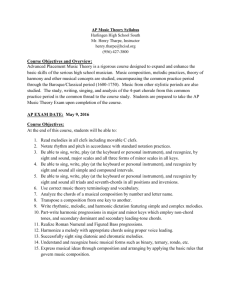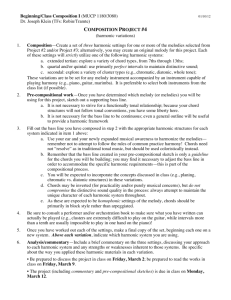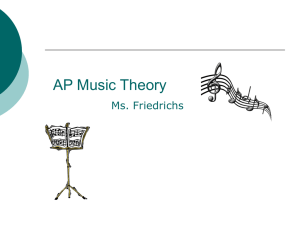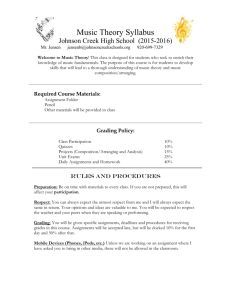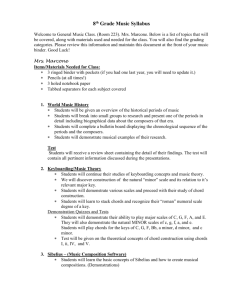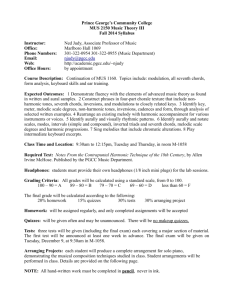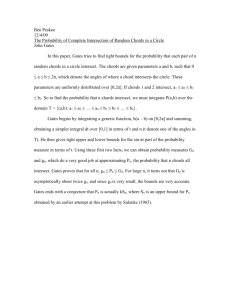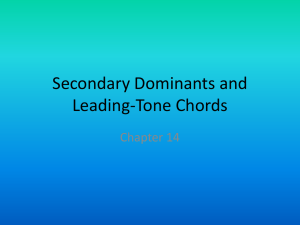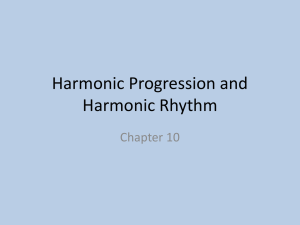Primary Texts - School District of Clayton
advertisement
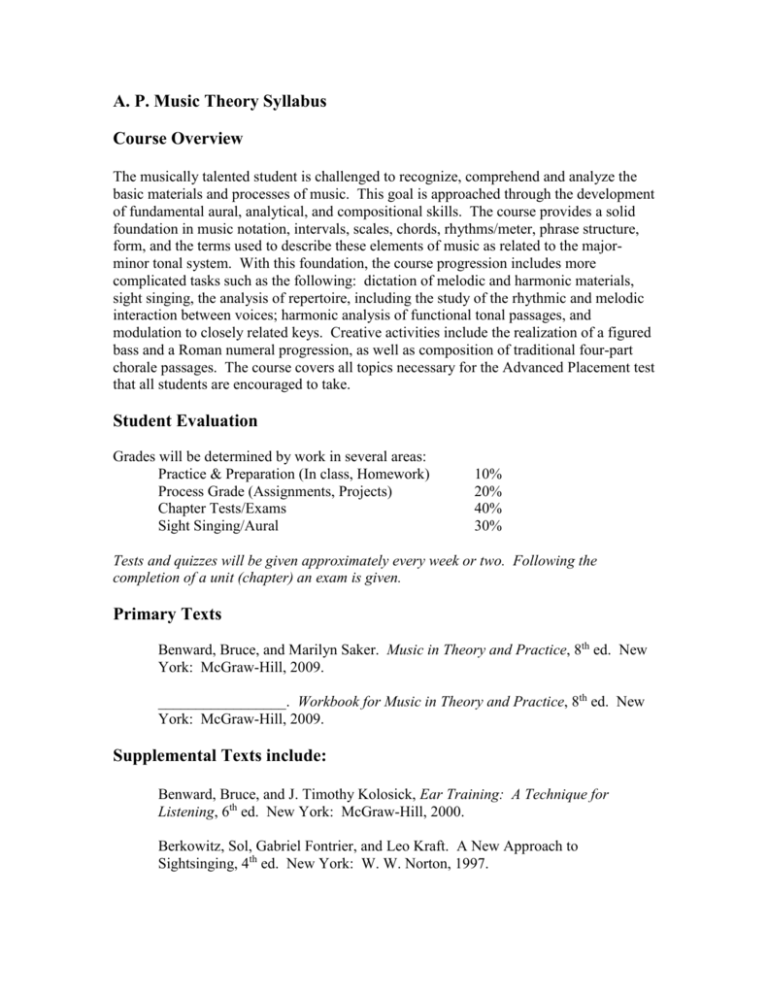
A. P. Music Theory Syllabus Course Overview The musically talented student is challenged to recognize, comprehend and analyze the basic materials and processes of music. This goal is approached through the development of fundamental aural, analytical, and compositional skills. The course provides a solid foundation in music notation, intervals, scales, chords, rhythms/meter, phrase structure, form, and the terms used to describe these elements of music as related to the majorminor tonal system. With this foundation, the course progression includes more complicated tasks such as the following: dictation of melodic and harmonic materials, sight singing, the analysis of repertoire, including the study of the rhythmic and melodic interaction between voices; harmonic analysis of functional tonal passages, and modulation to closely related keys. Creative activities include the realization of a figured bass and a Roman numeral progression, as well as composition of traditional four-part chorale passages. The course covers all topics necessary for the Advanced Placement test that all students are encouraged to take. Student Evaluation Grades will be determined by work in several areas: Practice & Preparation (In class, Homework) Process Grade (Assignments, Projects) Chapter Tests/Exams Sight Singing/Aural 10% 20% 40% 30% Tests and quizzes will be given approximately every week or two. Following the completion of a unit (chapter) an exam is given. Primary Texts Benward, Bruce, and Marilyn Saker. Music in Theory and Practice, 8th ed. New York: McGraw-Hill, 2009. _________________. Workbook for Music in Theory and Practice, 8th ed. New York: McGraw-Hill, 2009. Supplemental Texts include: Benward, Bruce, and J. Timothy Kolosick, Ear Training: A Technique for Listening, 6th ed. New York: McGraw-Hill, 2000. Berkowitz, Sol, Gabriel Fontrier, and Leo Kraft. A New Approach to Sightsinging, 4th ed. New York: W. W. Norton, 1997. Burkhart, Charles. Anthology for Musical Analysis, 6th ed. Belmont, CA: Schirmer, 2003. Ottman, Robert W. Music for Sight Singing, 6th ed. Upper Saddle River, NJ: Prentice Hall, 2004. Turek, Ralph. The Elements of Music: Concepts and Applications, 2nd ed. Vol 1. New York: McGraw-Hill, 1995. Course Planner Note: Chapter references are to the Benward and Saker textbook. First Semester - First Quarter Week 1 – Introduction and Chapter 1 Elements of musical sound. Review the fundamentals of music notation including the grand staff, clefs, octave identification, enharmonic equivalents, rhythm and meter, metric organization, simple and compound meters and dynamic markings. Weeks 2 and 3 – Chapter 2 Introduce diatonic scales (major and minors), solfeggio syllables, scale degree names, scale relationships, tonality, key signature, circle of fifths, miscellaneous scales (e.g. pentatonic, whole-tone, chromatic, blues, chromatic, non-diatonic). Weeks 4 and 5 – Chapter 3 Introduce concepts of the interval, consonance and dissonance, inversion, compound intervals, and transposition. Week 6 – Chapter 4 Elements of harmony: chord, the triad and its inversions, seventh chords and inversions, Roman numeral analysis, figured bass symbols, macro analysis and popular music symbols. Weeks 7 and 8 – Chapter 5 Cadences: harmonic (authentic, half, Phrygian, plagal, deceptive), and rhythmic. Nonharmonic tones: passing tone, neighboring tone, escape tone, anticipation, suspension, retardation, appoggiatura, neighbor group, pedal tone. Weeks 9 – Chapter 6 Concepts of melodic organization: motive, sequence, phrase structure, period, phrase modification through types of extension, and melodic structure. Sight-Singing Weeks 1-2 Weeks 3-4 Weeks 5-6 Weeks 7-9 Introduction to Solfege/Simple Time (Meter) Scale-Line Melodies Intervals from the Tonic Triad, Major Keys/Simple Time Intervals from the Tonic Triad, Major Keys/Compound Time Ear Training during First Quarter The focus is on scale-wise major and minor melodies, melodic and harmonic intervals beginning with 2nds and 3rds gradually increasing up to an octave; simple bass line dictation; triads; chord function beginning with I (i) - IV (iv) - V chords (and eventually adding the ii chord). Second Quarter Week 10 (Continuation of Chapter 6, melodic organization). Week 11 – Chapter 7 Texture and texture types: monophonic, polyphonic, homophonic, and homorhythmic. Textural reduction. Identification of textural elements to include primary and secondary melodies, parallel supporting melodies, static support, harmonic and rhythmic support. Week 12 – Chapter 8 Introduction to species counterpoint. Principles of voice leading in first species, twovoiced counterpoint. Composition of a counterpoint against a given cantus firmus. Weeks 13 and 14 – Chapter 9 Voice leading principles common to music from the common practice period. Guidelines for inviolate and occasionally broken rules are given. Analysis of chorale phrases. Stylistic practices of part writing. Stylistic practices of second inversion chords. Voiceleading guidelines. Weeks 15 and 16 – A.P. Practice Exam; Review and Catch-up Week 17 – Sight Singing and Listening Final Exams Week 18 - No scheduled classes -Written Final Exam Sight-Singing Weeks 10-11 Weeks 12-13 Weeks 14-15 Weeks 16-17 Week 18 Minor Keys; Intervals from the Tonic Triad Intervals from the Dominant Triad; Major and Minor Keys Further Use of Diatonic Intervals A. P. Practice Exam examples Final Exams Ear Training during Second Quarter The focus is on major and minor melodies with arpeggiation of I, IV and V (and diminished vii) chords and some larger leaps; non-harmonic tones; all triads; harmonic dictation increases to include I (i), ii, IV (iv), V, vi (VI) and diminished vii chords; cadences; outer voices; texture identification. Second Semester - Third Quarter Week 1 and 2 – Chapter 10 Harmonic Progression and Harmonic Rhythm: chord relationships, circle progression, determining harmonic rhythm. Harmonizing tonal melodies: chorale phrases and folk melodies. Week 3 and 4 – Chapter 11 Dominant Seventh Chord: inversions, resolution of the dominant seventh in circle and non-circle progressions. Week 5 and 6 – Chapter 12 Leading-Tone Seventh Chords: resolution of the tritone and seventh factors, voice leading of fully diminished and half-diminished vii chords. Week 7 and 8 – Chapter 13 Non-dominant Seventh Chords: analysis symbols, dominant and non-dominant function, circle progressions and non-circle treatment, resolution of the seventh factor. Week 9 and 10 – Chapter 14 Secondary Dominants and Leading-Tone Chords: characteristics, part writing, voice leading, and analysis of secondary dominants and leading-tone chords. Sight-Singing Weeks 1-2 Weeks 3-4 Weeks 5-6 Weeks 7-8 Weeks 9-10 Alto and Tenor Clefs Intervals from Dominant Seventh Chord Intervals from the Tonic and Dominant Triads/Simple and Compound Time Further Use of Diatonic Intervals Chromaticism Ear Training during Third Quarter The focus is on two-phrase melodies, phrase relationships and cadences; larger leaps, sequences, modulation to closely related keys; six-four chords, seventh chords; harmonic dictation includes all diatonic chords, seventh chords, and phrases that modulate to closely related keys. Fourth Quarter Week 11 – AP Practice Exam Week 12 – Chapter 15 Modulation: closely related keys, common chord modulation, pivot chord modulation, phrase modulation, chromatic modulation, analytical symbols for modulations. Procedure for harmonizing melodies that modulate. Week 13 – Chapters 16 and 17 Two-Part (Binary) and Three-Part (Ternary) Forms: Open and closed formal division, analysis of form in music. Compound forms, bar forms, expanded ternary, rounded binary, refrain and bridge. Other small forms include theme and variations and strophic. Week 14 Brief introduction to twentieth-century compositional techniques through analysis and listening examples. Review for AP Music Theory Exam. Week 15 Review for AP Music Theory Exam (to be given during week 16). Week 16/17/18 Work on final projects. Semester Two Exam. Sight-Singing Week 11 Weeks 12-15 Practice Exam Examples from miscellaneous choral literature and various sight singing texts. Focus on modulation to closelyrelated keys and secondary dominants. Ear Training during Fourth Quarter The focus is on melodies in two-phrase periods that include modulation and non-diatonic tones; harmonic dictation of chorale phrases containing secondary dominants and leading tone chords; harmonic relationships; small forms such as binary, rounded binary and ternary. Post AP Exam Activities Our AP class has one or two additional weeks of class meetings following the AP exam. During that time I allow the class to work on a mutually agreed-upon activity. In past years students have chosen to do in-depth analyses of favorite works (e.g. Beatles tunes), or write compositions. One class decided to write an “Alma Mater” for our school. The group began with the examination of other alma maters. (Many were found on a web search). The students then wrote a text appropriate for our school and showed the poem to an English teacher for comments. After composing a melody, the group made a fourvoice setting. The four-voice setting was written using Finale and then transposed for band instruments as well. Our band and choir later performed the selection at our school’s graduation ceremonies.
